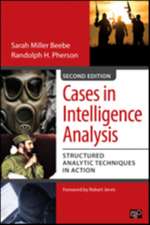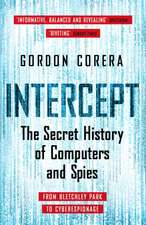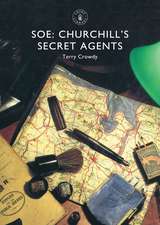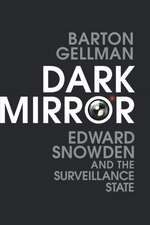The Five Disciplines of Intelligence Collection
Editat de Mark M. Lowenthal, Robert M. Clarken Limba Engleză Paperback – 16 mar 2015
Preț: 535.77 lei
Preț vechi: 724.02 lei
-26% Nou
Puncte Express: 804
Preț estimativ în valută:
102.53€ • 106.65$ • 84.65£
102.53€ • 106.65$ • 84.65£
Carte disponibilă
Livrare economică 24 martie-07 aprilie
Livrare express 08-14 martie pentru 25.51 lei
Preluare comenzi: 021 569.72.76
Specificații
ISBN-13: 9781452217635
ISBN-10: 1452217637
Pagini: 264
Dimensiuni: 152 x 229 x 17 mm
Greutate: 0.36 kg
Ediția:Revised.
Editura: SAGE Publications
Colecția CQ Press
Locul publicării:Washington DC, United States
ISBN-10: 1452217637
Pagini: 264
Dimensiuni: 152 x 229 x 17 mm
Greutate: 0.36 kg
Ediția:Revised.
Editura: SAGE Publications
Colecția CQ Press
Locul publicării:Washington DC, United States
Recenzii
“The Five Disciplines of Intelligence Collection fills a real need for a basic guide to the key intelligence disciplines. It will be especially useful to intelligence practitioners and users of intelligence who need to know how intelligence is collected as well as the strengths and limitations of collection methods. Those who teach intelligence and national security issues, as I do, will find this book of immense utility. Lowenthal and Clark are extremely well qualified to compile this work because both are "insider" career intelligence professionals of the highest order who know their subject.”
“Lowenthal and Clark have done us a major service with this edited work. By organizing it around the five major intelligence “disciplines” (human, signals, geospatial, measurement and signature, and open source), they show us how each has developed over time, in collecting and analyzing information, in support of U.S. national security. Though all the authors have technical expertise, the work is clearly written and is accessible to a wide variety of audiences, including students, novice analysts, policymakers, and even the public, who need to understand the strengths—and limitations—of intelligence. I highly recommend it.”
“Lowenthal and Clark have done us a major service with this edited work. By organizing it around the five major intelligence “disciplines” (human, signals, geospatial, measurement and signature, and open source), they show us how each has developed over time, in collecting and analyzing information, in support of U.S. national security. Though all the authors have technical expertise, the work is clearly written and is accessible to a wide variety of audiences, including students, novice analysts, policymakers, and even the public, who need to understand the strengths—and limitations—of intelligence. I highly recommend it.”
Cuprins
Chapter 1: Introduction
Some Important Definitions
References
Chapter 2: Open Source Intelligence - Eliot A. Jardines
Defining Open Source Intelligence
History of OSINT
How OSINT Is Managed
Who Produces OSINT?
International OSINT
Private Sector OSINT
Types of Targets OSINT Works Best Against
Future Trends in OSINT
References
Chapter 3: HUMINT - Michael Althoff
What It Is
History
How HUMINT is Managed
Foreign Collectors of HUMINT
Best Targets
Future Trends
References
Chapter 4: Signals Intelligence: Continuing Evolution - William N. Nolte
SIGINT: The Cryptologic Base
From Morse Code to the First World War
The First World War
The Continued Evolution of SIGINT: The Interwar Years
The Evolution of SIGINT: The Second World War
SIGINT in the Cold War
SIGINT: An Assessment
The Information Revolutions and SIGINT: Computers, the Internet, and Cyber
References
Chapter 5: GEOINT - Darryl Murdock and Robert M. Clark
GEOINT Defined
A History of GEOINT
GEOINT’s Main Attributes or Components
How GEOINT is Managed
International GEOINT
The Types of Intelligence Targets Against Which it Works Best
References
Chapter 6: MASINT - John L. Morris and Robert M. Clark
Introduction
MASINT Defined
A History of MASINT
MASINT’s Main Sub-elements or Components
How MASINT is Managed
International MASINT
The Types of Intelligence Targets Against Which MASINT Works Best
References
Chapter 7: Managing Collection
References
Some Important Definitions
References
Chapter 2: Open Source Intelligence - Eliot A. Jardines
Defining Open Source Intelligence
History of OSINT
How OSINT Is Managed
Who Produces OSINT?
International OSINT
Private Sector OSINT
Types of Targets OSINT Works Best Against
Future Trends in OSINT
References
Chapter 3: HUMINT - Michael Althoff
What It Is
History
How HUMINT is Managed
Foreign Collectors of HUMINT
Best Targets
Future Trends
References
Chapter 4: Signals Intelligence: Continuing Evolution - William N. Nolte
SIGINT: The Cryptologic Base
From Morse Code to the First World War
The First World War
The Continued Evolution of SIGINT: The Interwar Years
The Evolution of SIGINT: The Second World War
SIGINT in the Cold War
SIGINT: An Assessment
The Information Revolutions and SIGINT: Computers, the Internet, and Cyber
References
Chapter 5: GEOINT - Darryl Murdock and Robert M. Clark
GEOINT Defined
A History of GEOINT
GEOINT’s Main Attributes or Components
How GEOINT is Managed
International GEOINT
The Types of Intelligence Targets Against Which it Works Best
References
Chapter 6: MASINT - John L. Morris and Robert M. Clark
Introduction
MASINT Defined
A History of MASINT
MASINT’s Main Sub-elements or Components
How MASINT is Managed
International MASINT
The Types of Intelligence Targets Against Which MASINT Works Best
References
Chapter 7: Managing Collection
References
Descriere
This book describes, in non-technical terms, the definition, history, process, management, and future trends of each intelligence collection source (INT).











